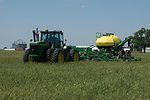Articles Tagged with ''prevent planting''
No-Till Farmer Web Page Offers Tips on Managing Prevented Planting Acres, Disaster Aid
The editors of No-Till Farmer, Strip-Till Farmer and Cover Crop Strategies assembled this web page to serve as a source for growers looking for options on prevented-planting acres in the U.S. and potentially find sources of disaster aid.
Read More




